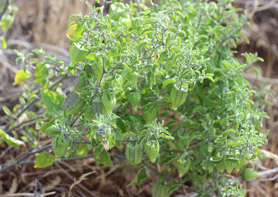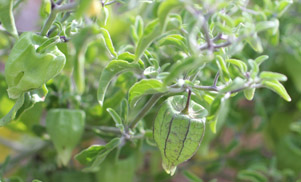 |
 |
Food:
"Archaeological evidence throughout the area makes clear that groundcherry fruits have been collected and eaten for at least 1,100 years, probably much longer.The plants seem to have a strong link with long-abandoned fields, and some anthropologists suspect that groundcherries were actually cultivated or at least encouraged among other crops during Anasazi times. --- All modern Puebloans who have an interest in wild plants know this one and its edible berry. When ripe, the orange or red berry may be eaten raw or cooked and used as a flavoring." (Dunmire and Tierney 206)
"Years ago it was reported that these plants were being cultivated by Zuni women, who boiled the ripe berries and ground them in a stone mortar with raw onions, chile, and coriander seeds for a kind of salsa. (Dunmire and Tierney 207)
"The Plains Indian women stewed the berries with honey or whatever substitute for sugar they might have, from which custom the pioneers learned to make them into jam." (Curtin 169)
"Use: Raw, cooked, or dried. Fresh tomitillo fruit is good in salads or as a garnish. Cooked, it is good in pies, salsa, pudding, kebabs, syrup, fruit leather, and pastries. The dried fruit tastes like dried apricots/raisins. Use dried fruits in cookies or cereal." (Seebeck 97)
Medicine:
"--- Spanish descendants, who mix either the ground green or ripe fruit with a pinch of salt, and compress it on the throat for tonsil trouble. (Curtin 169)